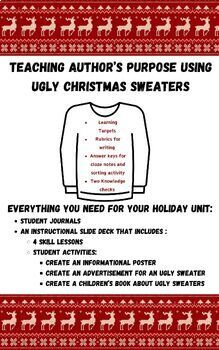Exploring Author's Purpose with Ugly Holiday Sweaters
- Google Drive™ folder

What educators are saying
Description
Looking for a quick three-week unit to fill the gap between Thanksgiving and Christmas break? Here it is! A 3 part mini unit to reinforce why authors write, to persuade, entertain, and inform their audiences.
In this unit, students will define the must-haves for each purpose by reading and exploring selections on how the ugly sweater tradition became a part of the US holiday season. In part two, they will design and create advertisements for a holiday sweater. In part three, they will write their own entertaining story about the holiday sweater tradition.
Everything you need is included in this mini-unit: student journals, instructional slide decks, bell ringers, timers, videos, jigsaw sorts, and rubrics to grade all the knowledge checks.
Enjoy the season!


